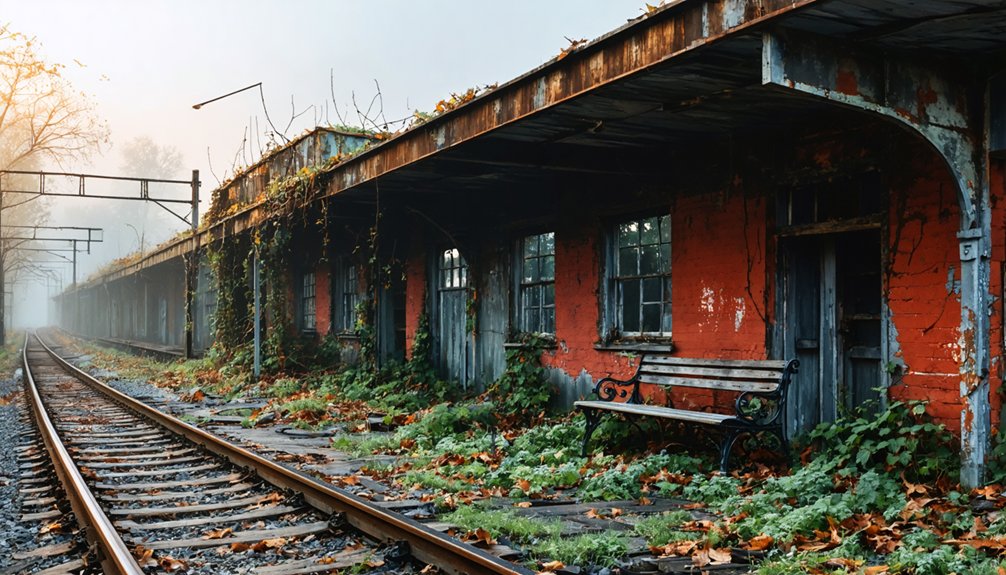You’ll find Burgess Railroad Station‘s remnants in Boyd County, Kentucky at 581 feet elevation near Gragston Creek. This Louisville and Frankfort Railroad hub operated from 1847, handling up to 16 passenger and 28 freight trains daily at its peak. The station’s brick buildings and roundhouse supported the region’s coal industry until mid-century economic shifts led to its abandonment. Today, scattered foundations and platform fragments tell a deeper story of Kentucky’s railroad heritage.
Key Takeaways
- Located in Boyd County, Kentucky at coordinates 38°16’12.60″ N and -82.581513° W, with an elevation of 581 feet.
- Originally established by Louisville and Frankfort Railroad after 1847, featuring passenger station, train shed, and roundhouse facilities.
- Experienced peak operations in early 1900s with 16 passenger and 28 freight trains daily.
- Declined due to Kentucky’s coal industry downturn, automobile travel emergence, and subsequent economic challenges.
- Now abandoned with only foundation remnants, scattered bricks, and deteriorated structures marking its historical presence.
Location and Geographic Features
Nestled in Boyd County, Kentucky, Burgess Railroad Station sits at coordinates 38°16’12.60″ N and -82.581513° W, with an elevation of approximately 581 feet above sea level.
The site’s geographic significance is enhanced by its proximity to Gragston Creek, which historically provided essential water access for the railroad operations and local community. The location can be found in UTM Zone 17S, providing precise geographic reference for mapping and navigation.
Gragston Creek’s waters were vital to both railroad activities and community life at this historic Kentucky location.
You’ll find the ghost town’s location documented on the USGS Burnaugh topographic map, with Hall Cemetery just half a mile away marking the area’s historical presence. Modern visitors must complete identity verification before accessing certain restricted areas of the site.
The site’s elevation impact on local weather patterns creates conditions that are strikingly wet, with precipitation levels higher than 64% of comparable locations.
The terrain’s positioning, about 243 feet lower than the nearest weather station at Huntington Tri-State, influences its unique microclimate.
Historical Railway Operations
When the Louisville and Frankfort Railroad established Burgess Railroad Station after 1847, it marked a significant development in Kentucky’s rail infrastructure. You’d have found a bustling one-story brick passenger station, complete with a train shed, freight shed, and roundhouse built from London-imported materials.
During its peak in the early 1900s, you could’ve witnessed up to 16 passenger and 28 freight trains daily passing through stations in the area. The railroad raised $800,000 from Louisville to support its extensive construction and operations.
While freight movement between the Kentucky River and Lexington proved essential for revenue, passenger decline became evident by mid-century. You’d have seen the challenges mount as steep grades required shifts from steam to gasoline engines, and derailment accidents diminished public confidence.
The Path to Abandonment
Although Burgess Railroad Station had thrived during the early 1900s, its path to abandonment began with the mid-20th century decline of Kentucky’s coal industry.
As mines shut down, you’d have witnessed the devastating economic factors that forced residents to leave: massive job losses, declining rail freight, and the closure of essential businesses.
The rise of automobile travel dealt another blow as new highways bypassed the town, leaving it increasingly isolated.
You can trace the social decline through the rapid exodus of families, closure of schools and shops, and the aging of those who remained.
Environmental challenges mounted as abandoned mines and derelict railroad infrastructure dotted the landscape.
Like many of Kentucky’s coal mining towns, the community struggled as residents could no longer afford their homes.
The town’s resource depletion ultimately sealed its fate when the last accessible coal seams were exhausted.
Unlike other historic Kentucky towns that found new purpose, Burgess faded into obscurity with minimal preservation efforts.
Surviving Structures and Remnants
Today’s visitors to Burgess Railroad Station will find fragments of its railroading past scattered across the landscape.
You’ll discover partially intact foundations beneath years of overgrowth, with stone and concrete footings that once supported the depot’s main structure. The original platform remnants, though obscured by vegetation, remain identifiable through careful ground surveys.
While the station’s main building no longer stands, you might spot architectural fragments like scattered bricks or deteriorated wooden elements amid the ruins. Similar to Lancaster’s historic Steinman Hardware Building, these architectural remnants provide valuable insights into late 19th-century construction methods.
Time-worn bricks and weathered wood pieces tell silent stories among the scattered remains of the vanished station building.
The site’s rail infrastructure lives on through visible railbed contours and occasional track remnants. You can trace the station’s footprint through surviving landscape modifications, including embankments and cuttings that shaped the surrounding terrain.
Nearby cemeteries and water features offer glimpses into the community that once thrived around this transportation hub.
Legacy in Kentucky’s Railroad Heritage
As an essential node in Kentucky’s late 19th-century rail network, Burgess Railroad Station played a significant role in connecting rural communities to major urban centers and trade routes.
You’ll find its railroad significance reflected in how it strengthened local agricultural economies by providing efficient freight services for dairy, grain, and livestock products.
The station’s economic impact extended beyond simple transportation – it transformed the region into a vibrant trade hub where farmers could sell their products and access broader markets.
Early settlers in the region relied on rivers and streams for transportation before the railroad’s arrival, making trade more challenging and seasonal.
As part of the larger network connecting to the Illinois Central and Louisville & Nashville Railroads, Burgess served as a vital link to major cities like Chicago and New Orleans.
This connectivity helped diversify local economies and minimize the risks associated with river transport. Similar to the historical Wilderness Trail, the railroad provided settlers with a safer alternative to river travel while enabling the transport of goods and supplies.
Frequently Asked Questions
Are There Any Paranormal Activities Reported at Burgess Railroad Station?
You’ll discover numerous ghost sightings and spectral encounters at the tracks, including phantom train whistles, vanishing illuminated carriages, unexplained metal clanking sounds, and the lingering scent of burning coal.
What Caused the Fires That Damaged the Original Station Buildings?
You won’t find definitive answers in historical records about specific fires, as fire investigations from that era weren’t well documented. Common causes likely included electrical issues, locomotive sparks, or wooden structure vulnerabilities.
Which Famous Historical Figures Passed Through Burgess Railroad Station?
You won’t find records of any famous historical figures at this station. Despite its cultural significance as a Kentucky rail stop, no notable travelers were documented passing through this location.
When Was the Last Passenger Train Service at This Station?
Like clockwork from a digital universe, you’d find the last train service ended April 30, 1971, when the George Washington made its final scheduled stops at 9:08 a.m. eastbound and 4:20 p.m. westbound.
Did Any Major Railroad Accidents Occur at Burgess Station?
You won’t find records of major train derailments or accidents at this location. While Kentucky’s railways faced safety regulation challenges and incidents elsewhere, no significant disasters are documented at Burgess Station.
References
- https://en.wikipedia.org/wiki/Tombstone_Junction
- https://lagrangerailroadmuseum.org/qr-8-defunct-ky-railroads
- https://www.gardenstogables.com/bygone-history-and-romance-the-l-n-passenger-depot-in-greensburg-kentucky/
- https://www.anyplaceamerica.com/directory/ky/boyd-county-21019/locales/burgess-railroad-station-historical–2088957/
- https://topoquest.com/place-detail.php?id=2088952
- https://www.topozone.com/kentucky/boyd-ky/locale/burgess-railroad-station-historical-2/
- https://wbkr.com/visit-these-20-creepy-kentucky-ghost-towns-for-a-halloween-road-trip/
- https://www.mindat.org/feature-6353526.html
- https://latitude.to/articles-by-country/us/united-states/214132/burgess-railroad-station-kentucky
- https://geographic.org/geographic_names/usaname.php?uni=2088952&fid=usageo_1935



